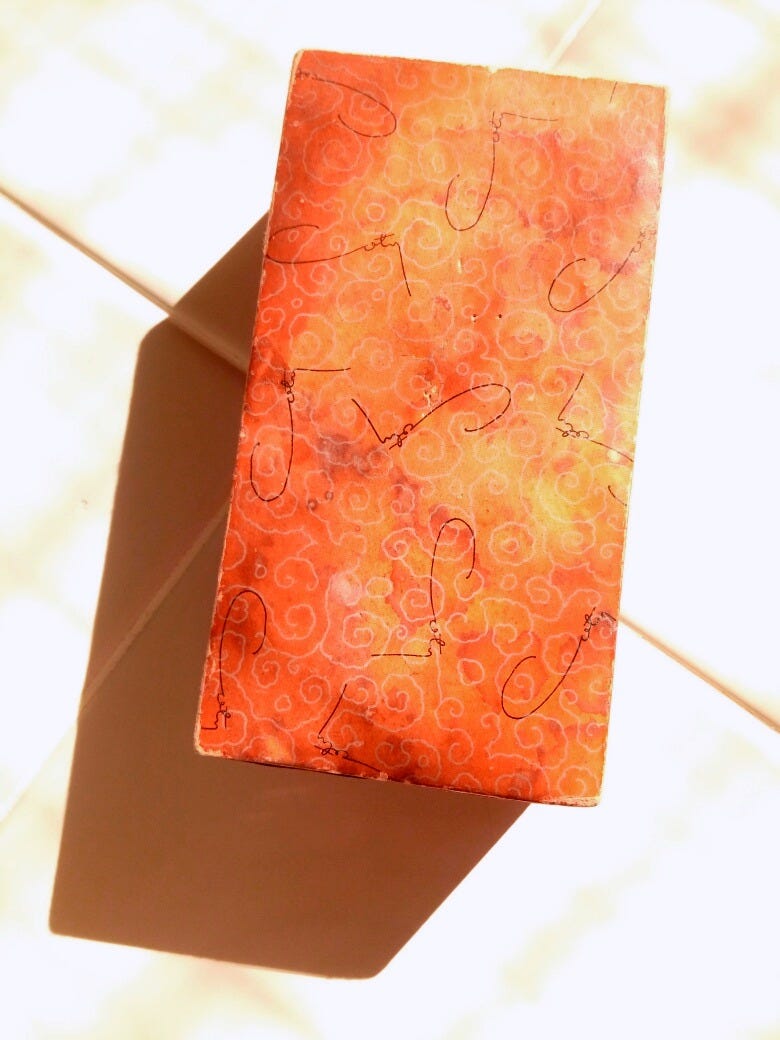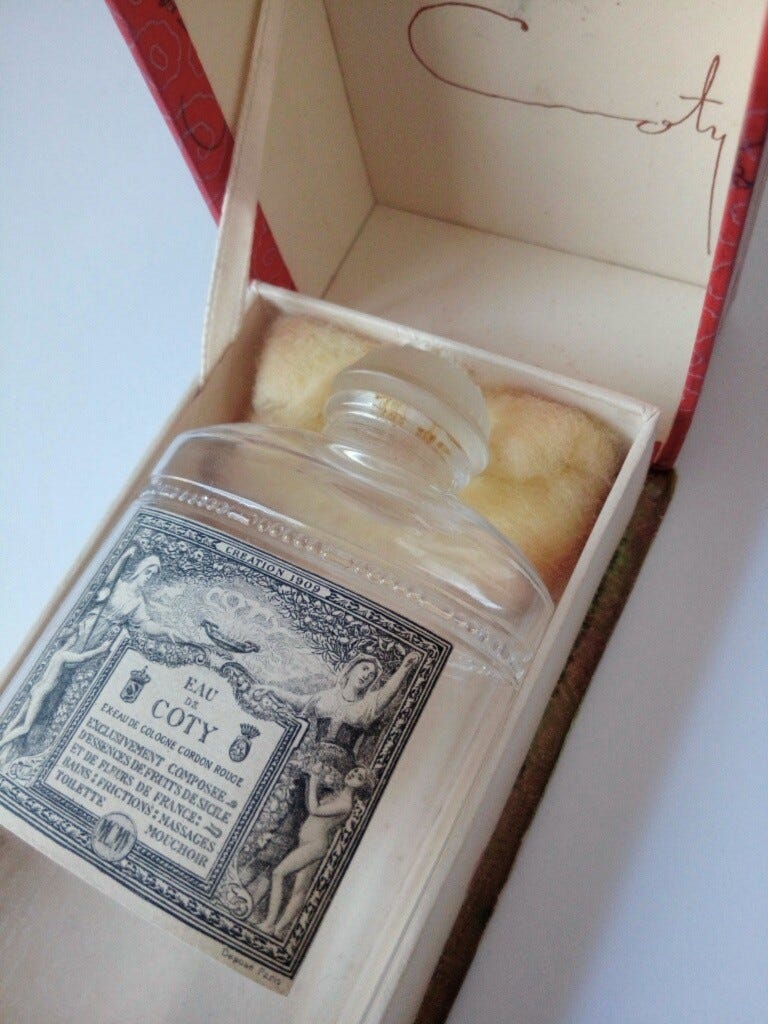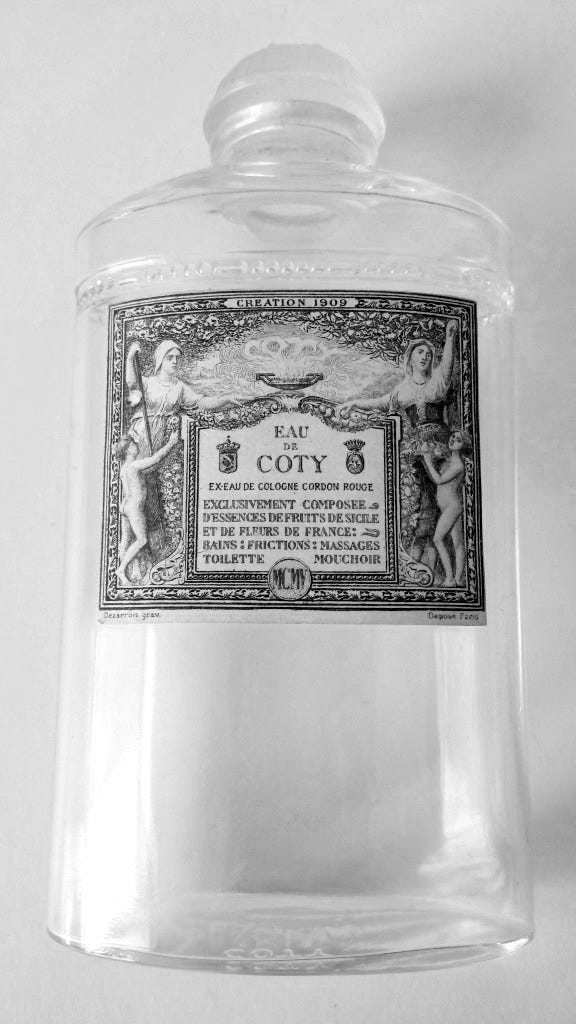What is Perfumery's Missing Link?
For his first job in perfumery, François Coty made colognes for a pharmacy in Paris. And then, when he began to write his own formulae, his boss was so impressed he sent Coty to a perfume maker in Grasse who made him an apprentice.
Years later, when he was a master perfumer with works like Rose Jacqueminot, L'Origan and Chypre to his name, Coty began thinking about Cologne once more. Being a pioneer he made something different, and to see how different it was, I am going to compare his Cologne with three others that were on sale at the time : 4711, Roger & Gallet Extra Vielle and Eau de Cologne du Coq.
Perfume doesn’t last for centuries, and Cologne is very fragile, so it’s not possible to know what historic colognes smelled like. But it is possible to compare (what was) a pristine bottle of Eau de Coty with modern versions of the classics.
Broadly speaking, they go like this:
4711 is mostly bland sweet powder with a little citrus tang.
Extra Vielle is a pithy citrus, with a powdery bland body, it comes with flowers and a pronounced bitterness.
Eau de Cologne du Coq is sparkly citrus with herbes de provence, and this is set to a backing of sweet powder and florals. This 'good cologne with a drop of Jicky' -as Luca Turin calls it- is the best of the three. In fact the citrus head of the Guerlain is better than the Coty but its base is rather weak.
In contrast to the citrus, flowers and powdery routine of the Cologne classics, Eau de Coty is a crackling mossy lemon and citrus verbena, which remains tangy as it moves into a lovely floral heart. This fades to the most ravishing sweet-brown woody base. The top and mid sections are well crafted but what makes Eau de Coty really different is the drydown, which is not present in legacy Colognes that simply fade away.
In the head of Eau de Coty there is a high grade lemon with mossy overtones, along with herbaceous verbena. These are backed with neroli, which - to quote Wikipedia - is ‘sweet honeyed and somewhat metallic with green and spicy facets’. Neroli (distilled orange flowers) makes up the core of the profile along with jasmine absolute — probably with synthetics and other floral notes.
The real brilliance of Coty was to pair this good but conventional Cologne with a dark base of vetiver and patchouli, which is augmented by oak moss and woods, synthetic vanilla and spices. There is also hydroxycitronellal, a molecule with a citrussy note that runs deep into the profile, and maybe elemi, which is a natural that does a similar thing.
Coty’s innovation was to take the citrus Cologne—which was light and fleeting—and merge it with a full bodied structure with a proper drydown. The resulting profile is coherent, but it pays a price for its forced longevity. In the middle phase the tart citrus can feel out of place against the warm rounded notes of the base, but when the lemon finally fades out Eau de Coty comes into its own; the more it plumbs the resonant depths - the better it becomes; a masterclass in bottom-up construction.
The idea behind Eau de Coty is striking, and the quality is impeccable, but it lacks that final degree of perfection — like some other of Coty's works.
~~~ ~~~ ~~~
In the past, when it came to the Eau de Cologne, even perfumers like Aimé Guerlain did little more than write their own variations of the formula. Each of the classics improved on the last, but none of them sought to change the basic structure; they were just tinkering at the edges.
The reason for this timidity was the Cologne of 1709 by Jean-Marie Farina. It was the first manufactured cologne and came to be the gold standard. "It bothers nobody" asserted Louise d'Alcq in her Manuel de Beauté, written in the early eighteenth century, "its perfume pleases everyone" she said.
This view—which saw Eau de Cologne as a perfume panacea—held it to be the sillage of the chaste woman, while patchouli was the odor of the courtesan. The moralizing was tied to personal hygiene. Those (affluent) people who had indoor plumbing and washed regularly could afford to wear a light citrus fragrance, but the poor and durty prostitutes wore cheap and heavy scent to hide their licentiousness.
By the time Coty faced down this idea in 1909, the schism between ‘acceptable’ and ‘transgressive’ perfume had been around for two centuries. With Eau de Coty he put paid to the idea with a stylish combination of ‘chaste Cologne’ and ‘prostitute Patchouli’; a perfume that allowed women to smell fresh and sensual without damaging their reputation.
~~~ ~~~ ~~~
Eau de Coty was influential. Its spirit appeared 60 years later in the sweet brown woody-citrus of Eau Neuve by Lubin. A vintage sample of Eau Neuve gives an idea of what the Coty smelled like. Ô de Lancôme and Eau de Rochas—which followed soon after—were in the same vein but drier and less sensual.
This cologne / eau de toilette dynamic is behind the fresh flankers of modern Eaux de Toilette which appeared in recent summers. And many original works have taken it further. With their durable citrus and woody-spicy bases, Monsieur Balmain, cK One and Déclaration Cologne are examples of this. There are also Vetivers with citrus head notes that echo the
layout of Eau de Coty.
~~~ ~~~ ~~~
By mixing Eau de Cologne’s freshness with the sensuality of Eau de Toilette, Coty came up with the Cologne de Toilette : perfumery's missing -but important- link.



